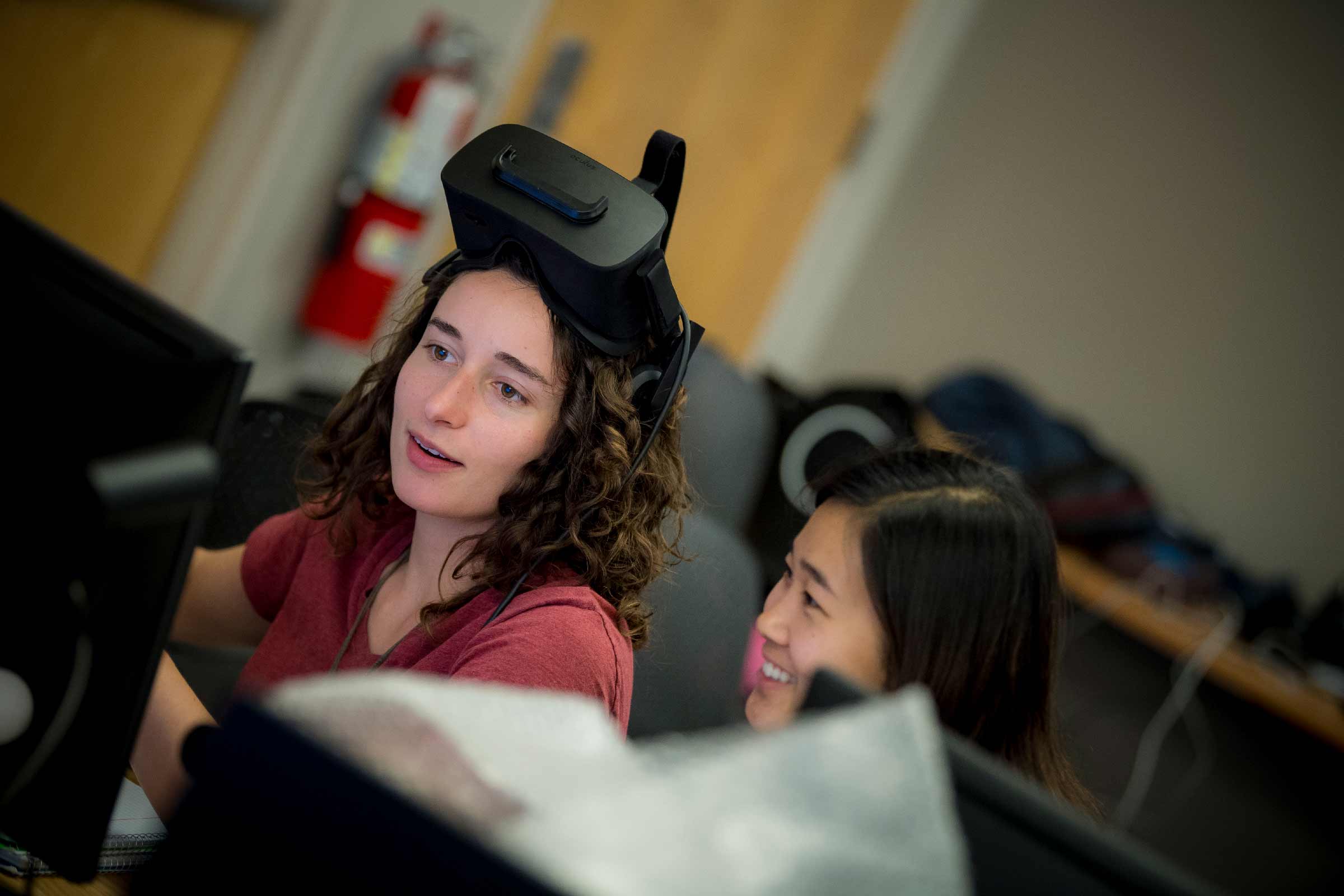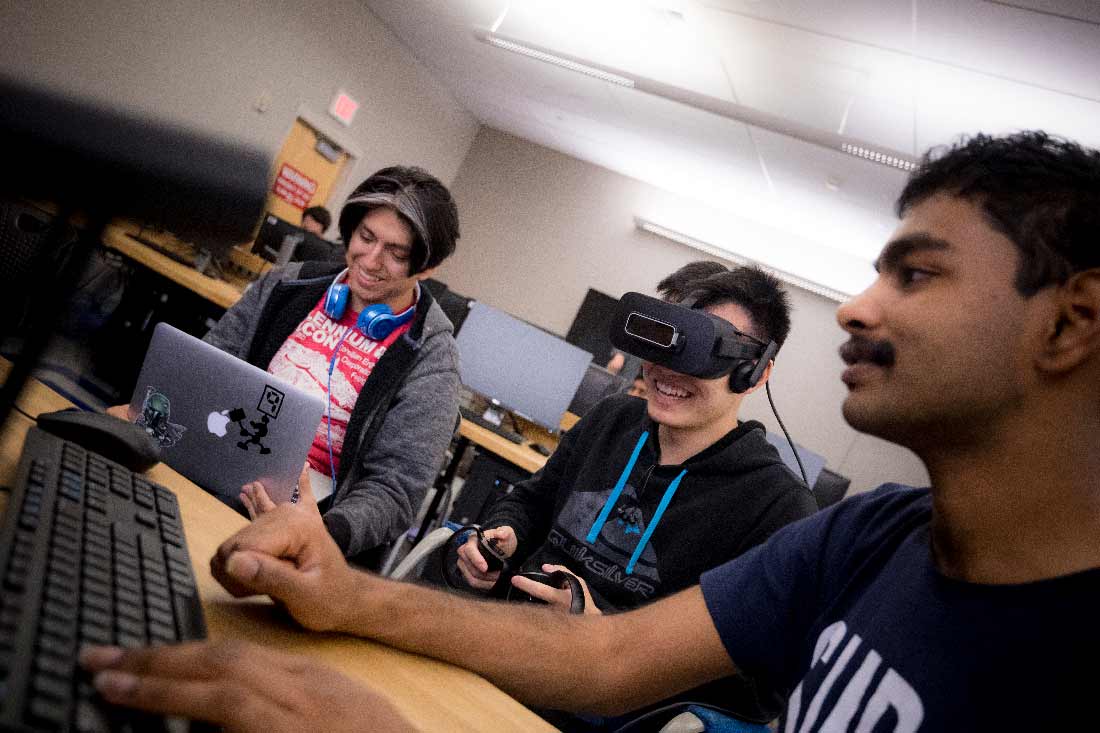
By:
- Deborah L. Jude
Published Date
By:
- Deborah L. Jude
Share This:
Hacking into a Lost World
Undergrads re-create at-risk archaeology sites in virtual reality as part of hackathon

UC San Diego engineering and archeology undergraduate students partnered up for the worlds first cyber-archeology hackathon. Photos by Erik Jepsen/UC San Diego Publications
Somewhere in the at-risk ruins of Khirbat en-Nahas in the Faynan region of southern Jordan lie untold stories of copper mining and smelting industries from the time of David and Solomon and the Edomite kings. Stories that, until now, could only be told in words, maps and photographs. Thanks to UC San Diego engineering and archaeology students that teamed up for the world’s first cyber-archaeology hackathon, the story of King Solomon’s copper mines now exists in virtual reality.
The marriage of archaeology, computer science, engineering, and the natural sciences, cyber-archaeology enlists the help of technology to safeguard the past for future generations. During the event, which ran from April 7 to 9, undergraduate students were given access to “virtual remains” from at-risk archaeological sites excavated by UC San Diego archaeology teams. The students faced the challenge of weaving this digital data, over the course of a weekend, into an engaging virtual reality experience that would help draw more people to the stories and lessons that history has to tell.
The hackathon was hosted by the Virtual Reality (VR) Club at UC San Diego in partnership with the Center for Cyber-Archaeology and Sustainability, which is housed in UC San Diego’s Qualcomm Institute.
“This is the first time something like this has been done,” said Connor Smith, third year computer science major, president of the VR Club and the event’s organizer. “Virtual reality is a multidisciplinary field, and a great medium for preserving the past. We wanted to bring together the subject matter experts, cognitive scientists, and engineers that could bring these stories to life.”
The winning project, called “Little Connor and the Ore of the Covenant,” allows users to interact with, and take part in, the process of copper production in the Iron Age by placing them in a virtual reality recreation of mines linked to Khirbat en-Nahas (Arabic for ‘Ruins of Copper’) and immersing them in the different stages of copper production. The site dates to the 10th century BC, the time of ancient Hebrew kings David and his son, Solomon.

The students had 36 hours to weave digital data frrom archaeological digs by UC San Diego teams into an interactive virtual reality experience.
“Our goals with this project were to tell a story that would resonate with our users as well as explore new interaction paradigms that could potentially increase engagement and retention within the experience,” said Christian Gutierrez, a senior cognitive science student with an emphasis in human-computer interaction and one of the members of the winning team.
Other members of the winning team included UC San Diego students Connor Shade (B.S., Study of Religion, ’17), Chen Liu (B.S., Computer Science, ’19) and Zhuoqun Xi (B.S., Undeclared, ’19).
As part of the hackathon, students had access to personal Virtual Reality Oculus Rift and HTC Vive headsets, as well as VR-ready computers in UC San Diego’s new Virtual Reality Lab in the UC San Diego Jacobs School of Engineering.
According to Thomas Levy, distinguished professor of anthropology and director of the Center for Cyber-Archaeology & Sustainability at UC San Diego, the students could choose digital data assets from five UC San Diego archaeology excavation sites in Jordan, Greece and Guatemala. Of those they chose two: Iron Age (ca. 1200 - 900 BC) Khirbat en-Nahas — a massive copper production site from the time of David and Solomon and the Edomite kings and Khirbat Nuqayb al-Asaymir (ca. 1050 - 1400 AD) — a Middle Islamic (Medieval) copper production site that emerged when the Crusaders controlled the coast of Israel and Pope Innocent III forbade the import of copper and other metals to the Arabs.
Both sites are in the Faynan copper ore zone of southern Jordan where Levy directs a long-term study with his Jordanian colleague Mohammad Najjar. Anthropology graduate students Matt Howland, Brady Liss and Ian Jones had joined Levy in Jordan to carry out the actual excavations of the sites used in the hackathon.
Students given access to a wealth of raw digital data, including 3D models of the entire excavation sites shot from helium balloon platforms by Levy’s team. They also were provided with terrestrial laser scans, 3D models of rooms, features and artifacts, digital photographs of thousands of artifacts, and 3D models provided by NOVA Television, which produced a documentary about the UC San Diego team’s research in Jordan called ”Quest for Solomon’s Mines.“
For Gutierrez, the hackathon was a dream come true. “During my childhood, I was captivated by dinosaurs and the origins of humankind. I dreamt of growing up and becoming an archaeologist someday. After discovering how virtual reality can help advance archaeology, I’m definitely going to explore the field of cyber-archaeology even further."
All of the teams received cash prizes, donated in part by the Geisel Library, the San Diego chapter of the Explorers Club, the Norma Kershaw Family Foundation, the Potamianos Family, and the Center for Cyber-Archaeology & Sustainability.
The winning teams will have their projects featured on the large-scale immersive VR platform at the Geisel Library CAVEkiosk and have a chance to undergo further development by the Center for Cyber-Archaeology & Sustainability. To get involved, visit ccas.ucsd.edu/.
The Center for Cyber-Archaeology and Sustainability was established as part of At-Risk World Heritage and the Digital Humanities, a cyber-archaeology project awarded a $1.06 million, two-year UC President’s Research Catalyst Award from the University of California (UC) Office of the President to a consortium of archaeologists and information technologists on four UC campuses: UC San Diego, UCLA, UC Berkeley and UC Merced.
Share This:
You May Also Like
Stay in the Know
Keep up with all the latest from UC San Diego. Subscribe to the newsletter today.


